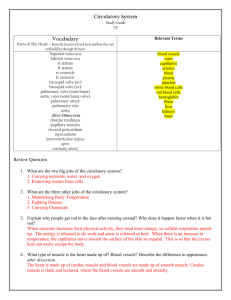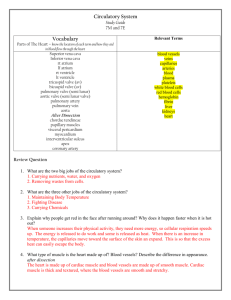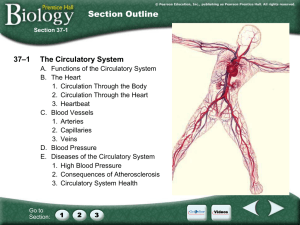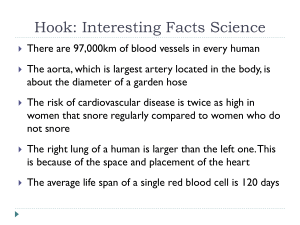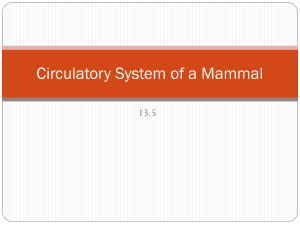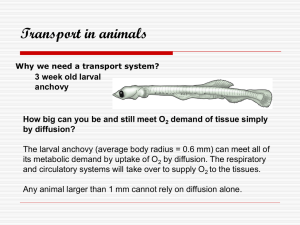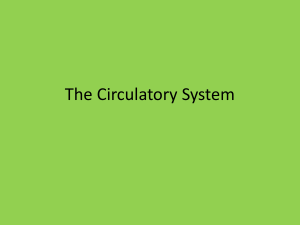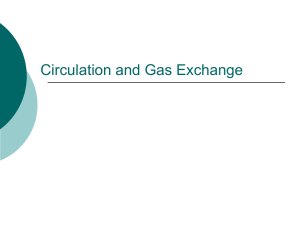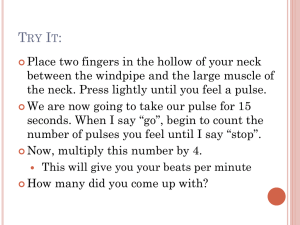Cardiovascular system
advertisement
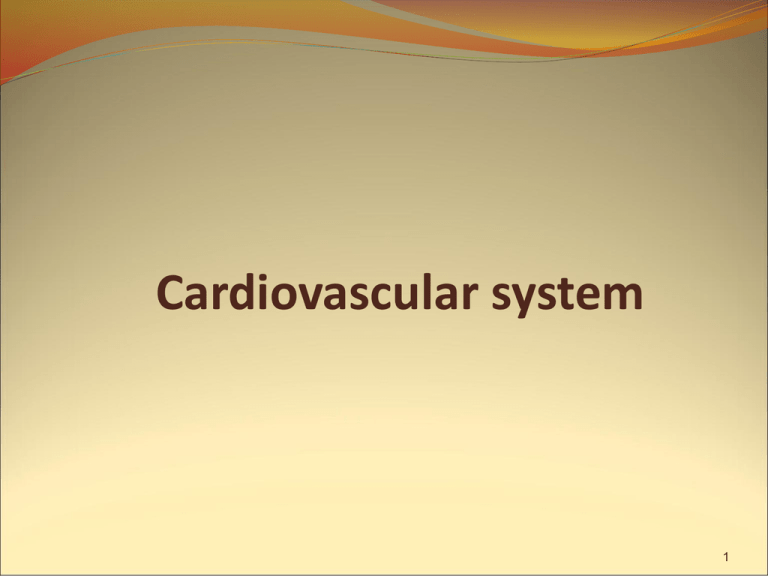
Cardiovascular system 1 The circulatory system The function is to transport O2 and nutrients to the cells of the body and to carry away CO2 and other wastes. To do this, the system must keep blood constantly circulating. 2 The circulatory system All vertebrates have a closed circulatory system where blood is transported in vessels, separate from the interstitial fluid. In an open circulatory system (as in arthropods) fluids return to the heart through ostia or open vessels. 3 Single-loop circulation Fish have a single-loop circulatory pathway: the heart has a single atrium and a single ventricle. 4 Two-circuits circulation Amphibians and most reptiles have a two-circuits circulatory pathway, with the heart divided into two atria and one ventricle. 5 Two-circuits circulation Birds and mammals have a two-circuits circulatory pathway with the heart divided into two atria and two ventricles. 6 The cardiovascular system A circulatory system consists of a pump (the heart), a fluid (the blood) and a series of blood vessels (the vascular system). All together those elements form the cardiovascular system. 7 The heart The heart has four chambers: two atria and two ventricles. A cardiac septum separates the heart into right and left halves. left atrium right atrium left ventricle septum right ventricle 8 An artery carries blood away from the heart while a vein takes the blood to the heart. Cardiac valves keep blood moving in the correct direction. superior vena cava pulmonary artery pulmonary veins aorta atrioventricular valve semilunar valve inferior vena cava 9 The heartbeat Electric rhythmic impulse move the heart. The contraction is called systole, the relaxation of the chambers is diastole. 10 The cardiac conduction system The heartbeat starts from the sinoatrial node (SA), the impulse-generating (pacemaker) tissue. The atrioventricular node (AV) causes the ventricle contraction. 11 Blood vessels Arteries Blood pressure in arteries and arterioles carries blood away from the heart. 12 Blood vessels Veins Skeletal muscle contractions return blood in veins and venules to the heart. 13 Blood vessels Capillaries Thin-walled capillaries permit exchange of materials and gas with the tissues. 14 Pulmonary and systemic circuits Cardiovascular systems includes two circuits. •Pulmonary circuit: pulmonary arteries take O2-poor blood to lungs while pulmonary veins return O2-rich blood to the heart. •Systemic circuit: left ventricles send O2-rich blood to aorta; vena cava takes O2-poor blood back to the right atrium. 15 Pulmonary and systemic circuits 16 Blood pressure Blood velocity depends on pressure and on capillaries area. Systolic pressure: is the pressure in arteries during ventricular systole. Diastolic pressure: is the pressure in arteries during ventricular diastole. 17 Vascular diseases A stroke (or cerebral ictus) occurs when a small cranial arteriole bursts or is blocked by an embolus. A heart attack occurs when a coronary artery (the artery that brings O2-rich blood to capillaries of the heart) is completely blocked. 18 Vascular diseases Healthy life style can help to prevent vascular diseases: •refraining from smoking •no drugs •controlling weight •healthy diet •monitoring cholesterol •exercising 19 Vascular diseases Cholesterol is an essential component of cell membranes and is carried by plasmic proteins (LDL and HDL). Anomalies in quantities of LDL or HDL can lead to the formation of cholesterol plaque in blood vessels. 20 Blood functions • Transports substances to and from capillaries where exchanges occur. • Helps the organism defend against pathogens. • Helps regulate body temperature. • Forms clots to prevent hemorrhages. 21 Blood composition Blood is composed of a liquid portion called plasma and formed elements: red and white blood cells, and platelets. Clotting Blood clotting involves platelets that release clotting factors at the site of the blood vessel damage. Fibrin threads provide a meshwork for a blood clot. 23 Blood stem cells Hematopoietic stem cells (HSCs), are multipotent stem cells, found in the bone marrow of adults, that can produce all the blood cell types. HSCs can be easily transplanted from pelvic bone. 24 Capillary exchange Between the arterial end and the venus end, substances diffuse according to the concentration gradient: •CO2 and waste produced by the cells move in; •C6H12O6, amino acids and O2 spread out. 25 Capillary exchange Lymphatic capillaries collect excess tissue fluid (called lymph) and return it to the vascular system. 26 AB0 classification system RBC membranes carry specific carbohydrates and proteins that behave as antigens when transplanted in incompatible organisms. Those antigens are classified as A and B and determine the type of blood. RH factor is another important antigen in matching blood types. 27 AB0 classification system Agglutination: clumping of RBC in the presence of an antibody that binds multiple antigens and joins the cells. No agglutination Agglutination 28 Online resources http://www.bbc.co.uk/schools/gcsebitesize/science/add_ocr_ga teway/living_growing/circulatoryrev1.shtml http://www.bbc.co.uk/schools/gcsebitesize/science/21c/keeping _healthy/heartdiseaserev1.shtml (pages 3, 4, 5) http://www.abpischools.org.uk/page/modules/heartandcirculatio n/index.cfm?coSiteNavigation_allTopic=1 Animations http://media.wwnorton.com/college/biology/discoverbio5/full/ 28_01/start.html http://media.wwnorton.com/college/biology/discoverbio5/full/ 28_02/start.html http://media.wwnorton.com/college/biology/discoverbio5/full/ 28_03/start.html http://highered.mcgrawhill.com/sites/0072495855/student_view0/chapter21/animatio n__cytotoxic__type_ii_hypersensitivity_.html http://highered.mcgrawhill.com/sites/0072495855/student_view0/chapter21/animatio n__hemoglobin_breakdown.html http://highered.mcgrawhill.com/sites/0072495855/student_view0/chapter22/animatio n__conducting_system_of_the_heart.html http://highered.mcgrawhill.com/sites/0072495855/student_view0/chapter22/animatio n__the_cardiac_cycle__quiz_1_.html 30

